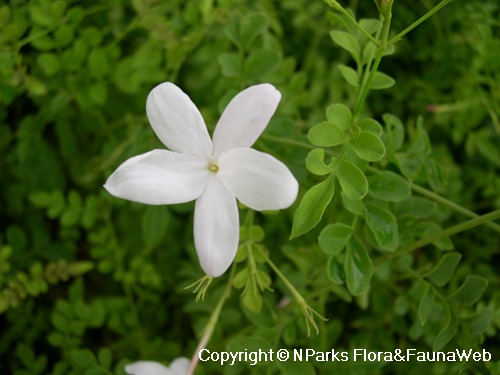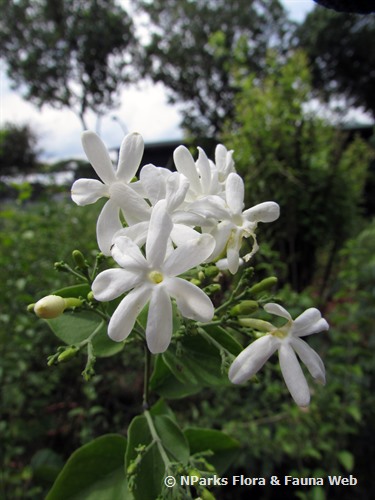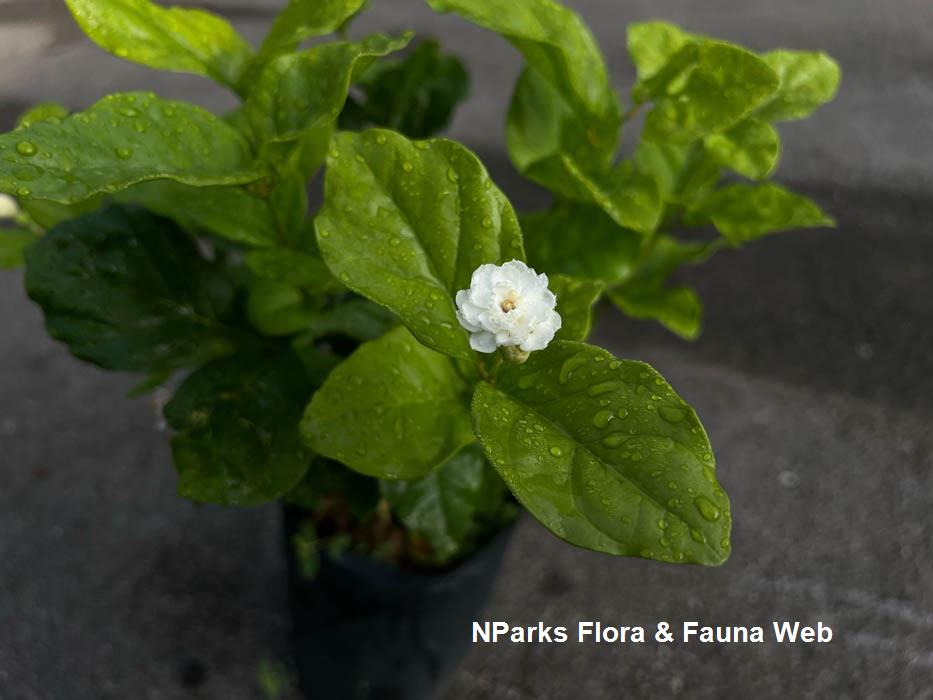.jpg)
Back
Jasminum grandiflorum L.
| Family Name: | Oleaceae |
| Synonyms: | Jasminum officinale subsp. grandiflorum, Jasminum officinale var. grandiflorum, Jasminum officinale f. grandiflorum |
| Common Name: | Spanish Jasmine, French Jasmine, 素馨花 |
Name
Classifications and Characteristics
| Plant Division | Angiosperms (Flowering Seed Plants) (Dicotyledon) |
|---|---|
| Plant Growth Form | Climber, Shrub |
| Lifespan (in Singapore) | Perennial |
| Mode of Nutrition | Autotrophic |
| Plant Shape | Weeping / Pendulous |
| Maximum Height | 5 m |
Biogeography
| Native Distribution | Africa, Arabia, Pakistan, China |
|---|---|
| Preferred Climate Zone | Tropical, Sub-Tropical / Monsoonal, Temperate |
Description and Ethnobotany
| Growth Form | An evergreen scandent shrub in the tropics with long, rather stiff branches. |
|---|---|
| Foliage | Leaves are compound with many small ovate leaflets, held opposite on the stems and glossy-green in colour. Leaf blade is glabrous, dark green in colour. |
| Flowers | Flowers are 5 cm in diameter, white, very fragrant and borne in clusters. Flower buds are pinkish in colour and floral initiation is promoted by high day and low night temperatures. Flowers open early in the morning and oil content decreases by early morning. |
| Fruit | Seldom formed, fruits are 2-lobed berries that turn black when ripe. |
| Cultivation | Plant prefers to grow in direct sun with adequate soil moisture and should be planted in moist, well draining, fertile soil that is rich in organic matter. Does not tolerate waterlogging. Growth and flowering are hindered by shade, prolonged drought, low daytime temperatures and cool wet conditions. Plants can get straggly with time and need to be prune periodically. Plants can get attacked by spider mites and are susceptible to root and stem rots due to overly wet conditions. |
| Etymology | The genus Jasminum is latinized from the Persian name, yasemin or Arabic, yasamin, for perfumed plants. The specific epithet grandiflorum means large flowers. |
| Ethnobotanical Uses | Food (Herb or Spice): In China and Indonesia, jasmine flowers are popular to flavour tea. Jasmine absolute (essential oil) and concrete (waxy solid containing essential oil) are used as additives in food and tobacco. Medicinal: Jasmine oil or essence is said to stimulate the reproductive system as an aphrodisiac. It also functions as a muscle relaxant. The infusion of flowers treats coughs and can be applied externally for skin diseases. Cultural / Religious: Fragrant flowers have been used for personal adornment, in religious ceremonies, strewn at feasts and added to baths. Essential oil extracted from the flowers is used in the perfumery industry. |
Landscaping Features
| Desirable Plant Features | Fragrant (Flowers) (Day), Ornamental Flowers |
|---|---|
| Landscape Uses | Container Planting, General, Flowerbed / Border, Hedge / Screening, Suitable for Hanging Baskets |
| Thematic Landscaping | Fragrant / Aromatherapy Garden |
| Usage Hazard - Cons | Weak Branches |
Plant Care and Propagation
| Light Preference | Full Sun |
|---|---|
| Water Preference | Moderate Water |
| Plant Growth Rate | Fast to Moderate |
| Rootzone Tolerance | Moist Soils, Well-Drained Soils, Fertile Loamy Soils |
| Diseases | Stem and root rot if plant is grown in wet conditions. |
| Pest(s) | Sucking Insects |
| Propagation Method | Stem Cutting |
Foliar
| Mature Foliage Colour(s) | Green |
|---|---|
| Mature Foliage Texture(s) | Smooth, Glossy / Shiny |
| Foliar Type | Compound (Even-Pinnate) |
| Foliar Arrangement Along Stem | Opposite |
| Foliar Shape(s) | Non-Palm Foliage (Ovate, Elliptical) |
| Foliar Margin | Entire |
| Foliar Apex - Tip | Acute, Rounded |
| Typical Foliar Area | Nanophyll ( 0.25cm2 - 2.25 cm2 ) |
Non - Foliar and Storage
| Stem Type & Modification | Woody |
|---|
Floral (Angiosperm)
| Flower & Plant Sexuality | Bisexual Flowers |
| Flower Colour(s) | White |
|---|---|
| Flower Symmetry | Radial |
| Inflorescence Type | Cyme |
| Flowering Period | Free-Flowering |
| Flowering Opening Time | Daytime |
| Flower Lifespan on Plant | Several Days |
| Flowering Habit | Polycarpic |
Image Repository
Others
| Master ID | 140 |
|---|---|
| Species ID | 1436 |
| Flora Disclaimer | The information in this website has been compiled from reliable sources, such as reference works on medicinal plants. It is not a substitute for medical advice or treatment and NParks does not purport to provide any medical advice. Readers should always consult his/her physician before using or consuming a plant for medicinal purposes. |

.jpg)
.jpg)





.jpg)
